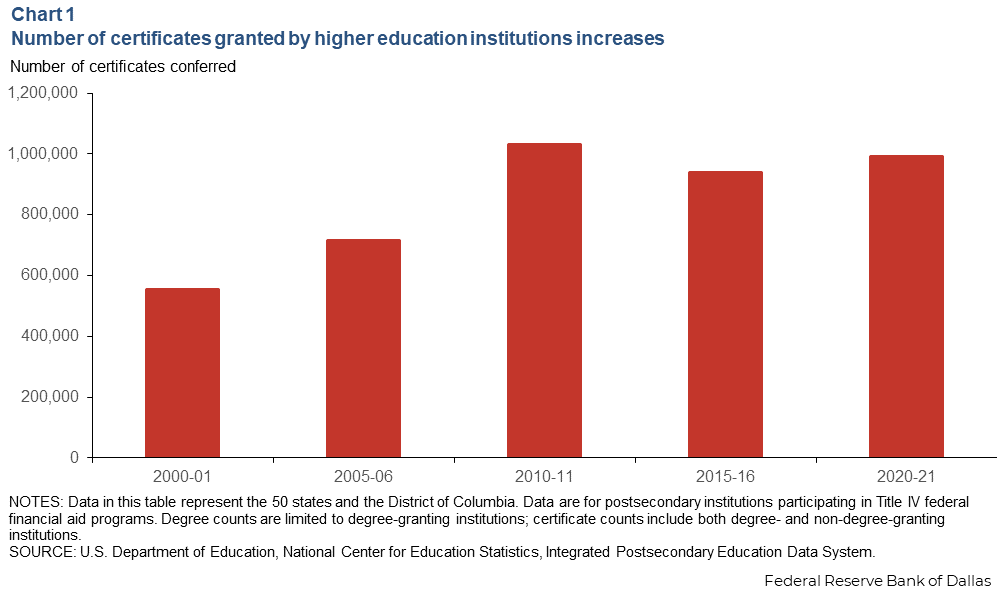
Short-term credentials meet growing interest among students, employers
The more you learn, the more you earn. It’s a phrase commonly used to describe the well-documented association between students’ educational attainment and their earnings and employment outcomes. For decades, higher education has been a reasonably reliable path to economic security, one that is correlated with intergenerational mobility. But for the past few years, researchers and policymakers have become increasingly concerned about the decline in college enrollment, citing rising tuition costs, increased student debt and other barriers. These concerns have ignited a deeper discussion about the potential of short-term credentials as an alternative path for learning.
Short-term credentials are generally postsecondary programs that require fewer than two years of schooling and grant awards other than degrees. This broad category includes professional licenses such as a nursing license, certifications to demonstrate up-to-date mastery of skills such as welder certification, and certificates that signify course completion such as a business analysis certificate. Short-term credentials can be granted by postsecondary institutions or industry associations. Proponents of short-term credentials hope these programs that are shorter (and often cheaper) than traditional college can boost economic mobility for students who would otherwise forgo a degree. Texas’ recent House Bill 8 exemplifies some of this interest, specifically naming certificates and other short-term credentials as areas of focus in the new community college funding model.
However, compared to the amount of research conducted on two- and four-year college degrees and their economic benefits to students, relatively little is known about the potential value of short-term credentials. Existing research offers mixed results on whether and for how long short-term credentials result in higher wages and better employment outcomes. The varying nature of these programs (program quality, credit hours required, relevance in labor market and other characteristics) contributes to the difficulty in studying outcomes.
Measuring employer appetite for short-term credentials
One of the most important factors in determining the value of short-term credentials is measuring employers’ perceptions of them. Specifically, how often do employers seek job candidates with short-term credentials? When they do, are these credentialed new hires rewarded with higher wages than they otherwise would have received? Are there particular industries or locations where credentials are more sought after or more highly compensated?
To address these questions, this article series uses job posting data from Lightcast to estimate the value employers place on short-term credentials.[1] Our first article in the series examines both the change in the number of people earning short-term credentials over time as well as trends in employer demand for these credentials. Results of this analysis and future articles in this series can shed light on the employers’ perceptions about the benefits of short-term credentials. [2]
Rising number of certificate earners and employer demand
Short-term credentials have become more popular among students. Data from the Department of Education shows that the number of conferred sub-baccalaureate certificates grew 89 percent between the 2000-2001 and 2021-2022 school years (Chart 1).[3]

The rise in the number of bachelor’s degrees conferred was a more muted 62 percent during the same timeframe.
With the number of certificate holders growing over time, was there a similar rise in the number of job postings seeking candidates with these qualifications? Yes, we found the rise in certificate holders was followed by an increase in job postings mentioning short-term credentials (Chart 2). The most rapid growth in credential demand was between 2013 and 2016, though there appears to have been an uptick in interest between 2021 and 2022.[4]

According to this analysis, while the share of job postings seeking candidates with short-term credentials was just under 18 percent in 2013, it reached nearly 30 percent in 2022. More research could show whether the renewed interest from employers is sustained or merely a short-term phenomenon.
Determining the value of short-term credentials
While our initial supply and demand comparison may be reassuring to proponents of short-term credentials, more questions need to be answered before determining their value. The next article in our series breaks out the demand for short-term credentials by educational requirements to determine who is benefiting the most from this rise in employer interest. Then we’ll look at whether employers reward credential holders with higher wages. When it comes to short-term credentials, is it true that the more you learn, the more you earn?
Notes
- We excluded job postings that require driver’s licenses and used a matching technique to remove duplications of postings within the same year. We did not differentiate between postings that asked for only one certification and those that listed multiple certifications.
- Our research has important limitations. First, Lightcast data does not necessarily capture all short-term credentials. Some certifications are implied but not explicitly mentioned in job postings and may therefore be underrepresented. In addition, our research sheds light on employers’ preferences for new hires, not necessarily internal promotional opportunities that don’t trigger external job postings. Furthermore, Lightcast data does not capture job postings that aren’t posted online. Finally, our research does not speak to the quality of certificate-granting programs and institutions.
- This data is only from Title IV institutions and therefore does not include certificates granted by private companies or other organizations outside of higher education. Were those to be included in the data, we expect the growth of certificates would be greater.
- While the most current data from the National Center for Education Statistics ends at the 2020-2021 school year, Lightcast data goes through 2022.
About the authors






